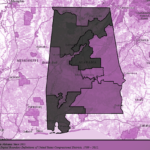This is the first article of a 10 part series on redistricting + apportionment + gerrymandering, in relation to Alabama.
Why you should care a lot about this (apparently obscure) governmental process: Do you care about fairness in the way democracy works? Do you care about whether your voice as a citizen in our democracy is heard or ignored? The way that districts are drawn can give an elected representative (and here we’re talking about Congress, but this applies to ANY level: Congress, state legislature, city council, school board, etc.) a motivation either to care about the views of all of their voters and try to take them into account, including voters of the other party, or to feel free to ignore them.
If you identify politically with a party that has an overwhelming majority in your district, then that might be just fine with you. Maybe you even think that winning is all that matters, so you feel justified in manipulating the current system to your advantage. If the system allows itself to be “gamed,” then you may think that if you don’t do it your opponent will. This is what’s happening with corruption of the redistricting process through “gerrymandering.” It’s important to remember that this has been done by BOTH parties over the years as they have tried to gain an unfair advantage. It is important to remember that gerrymandering corrupts BOTH parties, in that it guarantees all incumbents their current seats. Gerrymandering is explained in detail in part five of this series.
But consider how a person would feel who is in the minority party in your district: as if their voice is never heard or taken into account. And consider that it could be YOU in that position one day as political winds change (and we know that they always do). For example, Alabama’s 4th Congressional district, currently held by a Republican, was held by a Democrat from 1967 to 1997.
Let’s look at a situation in which a district is evenly divided, with 50% of the voters choosing each party. The elected representative (assuming that constituents aren’t voting a party line no matter what) would have to consider the views of constituents of both parties in voting and in crafting legislation, etc. But suppose that in such a situation (50/50), the district lines were redrawn to move some people out into neighboring districts and to draw others in from neighboring districts, such that the district was now 70/30, with the majority voting for the party of the representative. Compared to the 50/50 situation, would the representative now feel much of a need to listen to the 30%? This is an example of “gerrymandering” (which essentially turns the process backwards and allows elected representatives to select their voters).
Our focus right now is Congressional districts, that is to say, elected representatives for the US House of Representatives. Redistricting also happens at the state level, for the representatives elected to our House and Senate. It happens at every level of government where people are elected to serve. This process affects our lives in many ways, from federal legislation (such as the Voting Rights Act) to state legislation (such as ways to make government more transparent), all the way down to city council decisions on how funds will be allocated (such as adequately funding the local Registrar so that enough people are available to process absentee ballots).
How this series of posts will work: Because this topic is complex, we will break it down into bite-size pieces that are designed to build on each other. They will be written so that you can read them sequentially, but we will also try to make clear connections to previous material for people who jump in somewhere other than at the beginning.
The subject of each post will be clearly stated, and each will be numbered so that you can keep track and know how many steps there are in the series: 1 of 10, 2 of 10, etc. This should also allow you to skip topics that you already know about, and go right to information that is new, or that you need a refresher on, etc.
This series is a joint effort of the blog editor, Catherine Davies, and other members of the Advocacy Team and Board of the League of Women Voters of Alabama.


